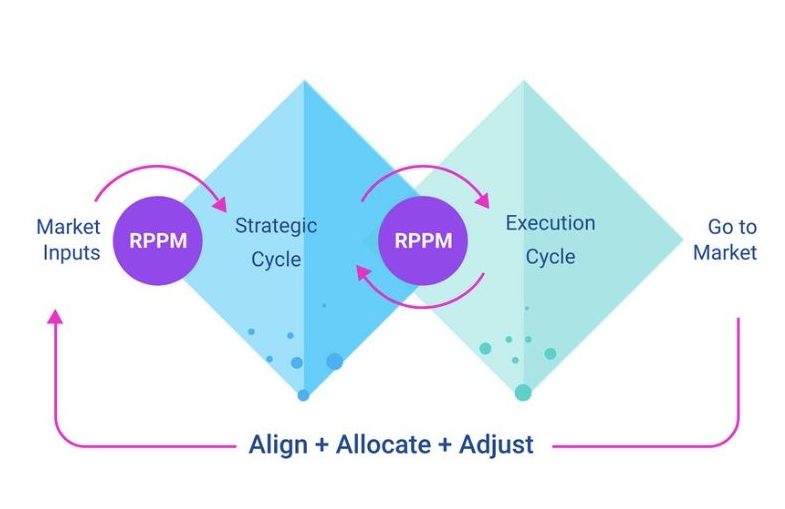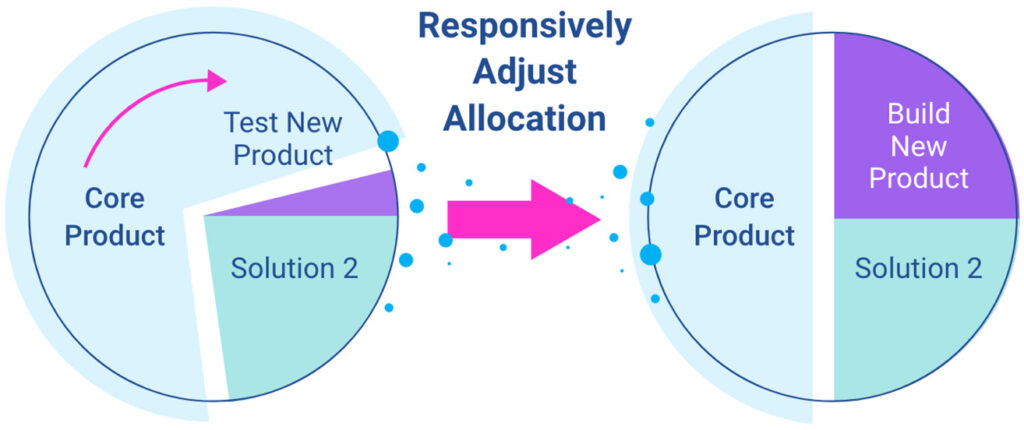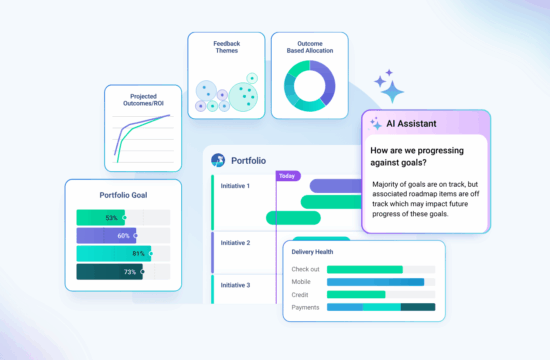“Can you remind me why Automated Reports has a much higher score than App Market Redesign? We spent quite a few days creating the formula and scoring all the items, but we don’t have anything for the partner team,” the Head of Product whispered to the Product Operations Manager in their stakeholder roadmap review meeting.
In the room, the channel partner lead was frustrated, “I shared my business plan with you all last quarter. And in our last executive offsite, we all agreed that increasing our partnership distribution is a top goal for all of us. But there is nothing on this roadmap.”
When the goals were first set and communicated, everyone agreed. But when the product teams started prioritizing the roadmap, goals were in a completely different realm.
Sound familiar?
80% of product teams struggle with competing priorities.
97% of companies fail to scale due to silos and misalignment.
The root causes?
- A linear, fixed-prioritization framework that doesn’t directly correlate to the evolving objectives.
- Disconnected or tangled strategies and executions that lead to building the wrong thing fast.
- Siloed teams lacking effective product operations, creating incongruent product experiences.
- Haphazard road-mapping that leads to incrementalism or half-finished products.
Winning teams adopt a Responsive Portfolio Management (RPPM) approach to dynamically connect strategy and execution.
What is Responsive Product Portfolio Management (“RPPM”)?
Responsive PPM, or ‘Responsive Product Portfolio Management‘ (RPPM), is an operating framework for organizations to dynamically assess, allocate, and deliver product investments, while also measuring and adapting their strategies based on outcomes. Responsive PPM enables strategic agility by providing flexibility and responsiveness to market changes and customer needs to achieve desired results, rather than just focusing on outputs alone. It’s a shift towards an outcome-driven approach to managing a product portfolio.
RPPM is a modern version of Strategic Portfolio Management (SPM). It supports the traditional focuses of SPM while offering different approaches. Both Responsive Product Portfolio Management (RPPM) and Strategic Portfolio Management (SPM) focus on managing portfolios to maximize business outcomes. However, RPPM is specifically designed for customer-centric, product-based (vs. project-based) organizations that need to continuously adapt to market changes, while traditional SPM is often more rigid, top-down, and project-driven.
Common Focuses Between RPPM and Traditional SPM
- Strategic alignment – Ensure execution maps to business goals.
- Governance and workflows – Standardized intake, approval, and prioritization.
- Resource and financial planning – Scenario planning and capacity management.
- Risk management – Oversight of dependencies and delivery risks.
5 Differentiated Principles of RPPM (or Modern SPM)
- Multidimensional product portfolios
- Collaboration across three operating horizons
- The double-diamond of strategy and execution workflow
- MoAR replacing ROI to assess opportunities
- Responsive portfolio adjustment (Re/balance)
Let’s dive into more details.
1. Multidimensional Product Portfolios
With RPPM, product portfolios can be viewed and assessed from multiple dimensions. The customer dimension reflects different types of customers, such as enterprise, SMB, domestic, or regions like EU, LATAM, etc. Additionally, the customer dimension often relates to terms like solutions and use cases for seemingly the same product. The objective dimension reflects the type of goals the product portfolio desires to achieve—such as growing new customers, retaining existing customers, innovation, etc.
2. Collaborative Three Operating Horizons
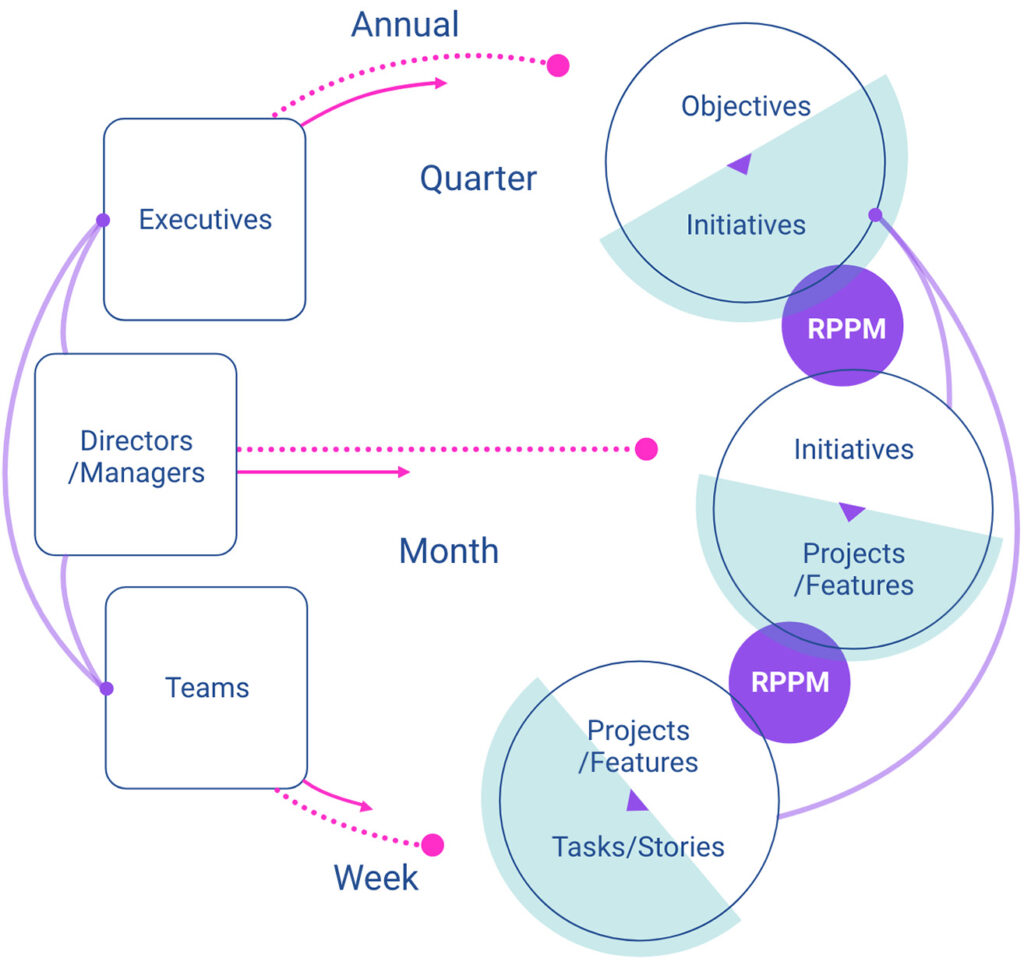
The key here is not having an annual, quarterly, or weekly event, but rather a rolling time horizon looking out to annual, quarterly, or bi-weekly goals. The details of the next level become fuzzier further into the future. This approach allows the organization to remain responsive while still rowing in the same direction.
3. Double Diamond Strategy and Execution Cycles
- The portfolio roadmap process has two distinct and interconnected phases: the strategic cycle and the execution cycle.
- In addition, each cycle focuses on a different time horizon at the same operating level (see diagram above).
- For instance, the strategic cycle has its own inner cycle of defining objectives, evaluating opportunities, and assessing resource allocation.
- The outputs of the strategic cycle become the goals for the execution cycle.
- Learn more about double diamond strategic planning and execution.
4. Use MoAR, Instead of ROI, for Prioritization
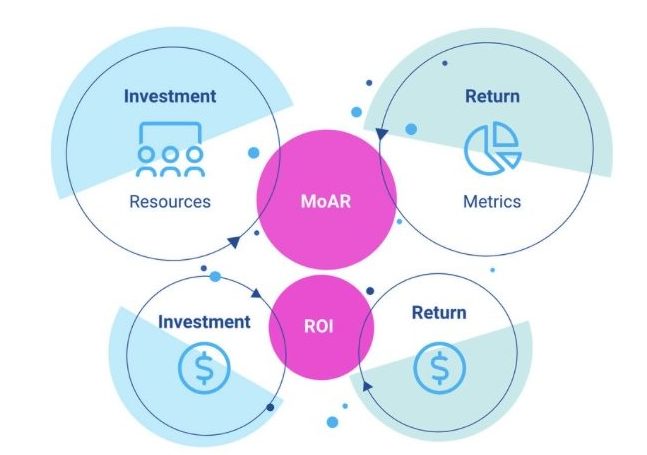
Prioritize with data – RICE, ROI, MOAR
Responsive PPM uses MoAR instead of ROI to evaluate cost vs. benefit.
- MoAR stands for Metrics over Available Resources.
- For an outcome-focused portfolio, metrics such as “Grow users by 5% in Q2” are more immediately measurable than dollar-based benefits such as a “gain a return of $1 million for feature A in 1 year.”
- Similarly, available resources are more immediate than a dollar investment when evaluating opportunity cost.
- By making costs and benefits more immediately measurable, MoAR enables faster and better product decisions.
- Learn more about MoAR.
5. Responsive Re/Allocation
- Traditional portfolio management allocates budget to products or projects and assumes the definition of projects ahead of execution.
- Responsive portfolio management allocates multi-dimensionally (e.g. towards objectives, customer segments). This provides autonomy in the execution cycle to empower innovation and faster decisions.
- Periodically, based on the level of operating cadence (point #2), the allocation may be adjusted to ensure the best overall results.
Join the Movement
Many successful organizations like PayPal, Spotify, Amazon, and Apple, have been operating with the Responsive PPM framework to achieve strategic agility at scale. If your company operates in fast-moving environment with limited time or resources, or focuses on product innovation, rapid iteration, and customer-driven growth, then Responsive Product Portfolio Management is essential.
To learn more about RPPM or get a free intro class with certification, visit ResponsivePPM.org
Need to put theory into practice and bring the RPPM to your organization? Book a Dragonboat demo today.

